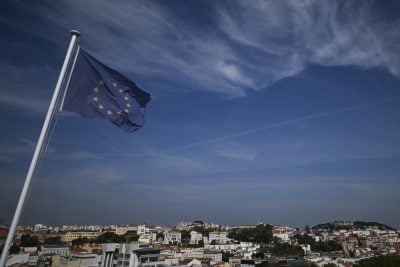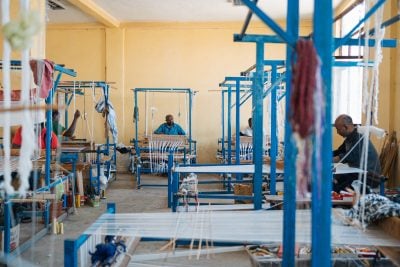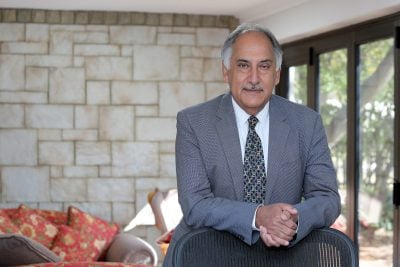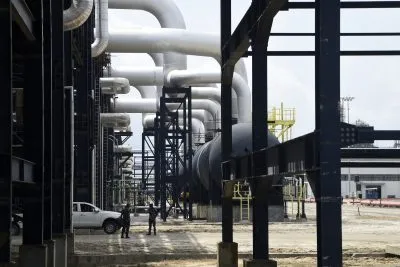A resplendent gold bow tie, a focused stare, and a wry smile, Dr Akinwumi Adesina proudly steps onto the stage of the African Investment Forum to announce a record year: In 72 hours, the African Development Bank (AfDB) and its partners managed to mobilize $31bn in investment interest from African and global investors.
Combined with $32.8bn from the rescheduled 2021 AIF—which took place virtually in March this year—the forum has doubled its capital mobilization with a total of $63.8 billion of investment interest in 2022.
The president of the AfDB, who initiated the forum in 2018, did not conceal his joy following the announcement of a ‘record year’ in terms of investment.
“In Nigeria, we have a song that says ‘everything na double double’,” said Adesina, before dancing on stage with Côte d’Ivoire’s prime minister Patrick Achi, in front of a beaming audience.

What might look like an American roadshow is in reality a very nascent forum which tries to be innovative in the way it portrays African presidents to international investors.
“It’s a very new way of doing business in Africa, where the heads of state act as CEOs and you can leave your Excellencies at the door. Just get in there and do excellent projects,” says Adesina.
Since its first edition, the AIF has had a reputation for mobilizing vast sums of capital for big infrastructure projects across the continent.
The $24 bn Liquified Natural Gas Project of Mozambique, the $15.6 bn Lagos-Abidjan Highway, or the $2.6bn Ai SkyTrain in Accra, are all deals that came out of the ‘invitation-only’ boardrooms settled alongside the event.
Four years ago, the AIF helped secure 52 deals worth $40bn in investment. Since then, Dr Adesina and his colleagues – Africa50, Afreximbank, African Finance Corporation, European Investment Bank, Islamic Development Bank, Trade and Development Bank, and the Development Bank of Southern Africa – are on a mission to market the continent’s untapped financial potential to African and international investors.
The vast networking event brings together African entrepreneurs, decision-makers, bankers and even athletes – Masai Ujiri, president of the basketball team Toronto Raptors, promoted investment in sport businesses – in a bid to assure investors that “Africa is not as risky as you think” and “perception is not the same as reality,” as Adesina puts it.
Investment interest despite a global downturn
This year, the AIF’s mission took place in tense business climate as the continent is severely impacted by the current economic crisis.
According to the IMF’s latest figures, sub-Saharan Africa’s GDP is expected to slow sharply by more than 1% point in 2022 due to tighter global financial conditions and a dramatic pickup in inflation.
Despite these strong challenges, African multilateral banks shrugged off the continent’s rickety recovery from Covid-19 and the global cost of living crisis.
“Africa is no different from the rest of the world when it comes to the global challenges we face today,” admits Adesina.
“But I do feel that African economies are quite resilient. If you take a look at the African Investment Forum that we held here, I saw a lot of enthusiasm. We were able to mobilise investment interest to Africa of $31 billion in less than 72 hours. It just shows you that Africa is bankable. It tells you that people have confidence in infrastructure projects in Africa.”
Three areas of investment were defined as a priority concern for African multi-lateral banks: agriculture, the electric cars’ value chain, and renewable energy.
On agriculture, the AfDB chief – Nigeria’s former agriculture minister – affirms that he will “dedicate investment only to the agro industrialization of countries so we can turn all of our rural areas away from being zones of economic misery to zones of economic prosperity.”
Rich mineral seams
AIF’s founders also recognize the importance of taking advantage of the booming battery market.
Africa is home to approximately 30% of the world’s mineral reserves, many of which are mined as raw materials for batteries. Zimbabwe and Namibia are among the top 10 countries for global lithium production, while cobalt and graphite is heavily mined in DRC and Tanzania.
“Do we want Africa to repeat the same mistakes? Exporting these raw materials outside to the rest of the world as people drive nice cars? We tried it before, and we said no,” said Adesina.
Finally, on the eve of COP27 in Egypt, African development bankers affirm their commitments towards renewable energy, recognizing the continent’s infinite solar, wind and water resources.
African development banks’ mission is not only to install solar panels in the Sahelian desert to boost the use of renewable energy, but for Africa to take part in the manufacturing of those panels.
“There is overconcentration of solar panel manufacturing in the world. If the production and manufacturing of solar panels were to collapse for some reason, as it happened with food during the Covid-19 pandemic, the continent must be prepared,” says Adesina.
“We decided collectively that we will look into designing, support and planning the manufacturing of polysilicon – the raw material needed to build solar cells – in Africa.”
Exploding Africa’s “infrastructure paradox”
Adesina nonetheless recognizes that even with the resources of all the multilateral development banks put together, it will still not be enough.
“There have been cases where you also find that China plays a very important role in terms of financing infrastructure in Africa. But you see a lot of pull back in time because as they deal with their domestic issues,” says the AfDB president.
To face the international capital slowdown in Africa, Adesina stresses the importance of Public-Private Partnership (PPP), saying that only a public sector’s involvement is not a sustainable way to finance infrastructure.
However, to attract the private sector, the continent needs to fix its ‘infrastructure paradox’, which sees only a few per cent of the projects initiated reach financial close.
If $31bn were drawn in investor interest at the AIF this year, who knows how much of this money will make it to the “financial transaction” stage?
“To attract the private sector to invest in infrastructure, it means that there has to be a lot of bankable projects that they can invest in. And that’s why we are investing in the preparation of projects, notably with our facility called NEPAD Infrastructure Preparation Facility,” says Adesina.
According to a recent McKinsey report, “less than 10 per cent of projects achieve financial close, with 80% failing at the feasibility and business-plan stage.”
“This low success rate represents a significant financial burden for infrastructure developers. For the six largest infrastructure markets in Africa, we estimate that the development costs of just the projects in the feasibility-study phase amounted to $30 billion,” says the report. Exactly the amount raised in investment interest at this year’s AIF.
One concrete example comes from a deal brokered during AIF’s first edition. At the time, Ghana and South Africa agreed to develop and finance the $2.6bn Accra SkyTrain project after signing a memorandum of understanding. Unfortunately, two years later, Ghanaian Minister of Railway Development John-Peter Amewu admitted that the Akufo-Addo-led government will not be able to provide Accra with a sky train as earlier as indicated, despite having invested $2m as a premium.
The failure of the project is still very controversial among the inhabitants of Accra who are still anticipating its completion, and chafing at the government expenditure of $2m down the drain.
McKinsey’s report also points to the issue of ‘short political cycles,’ in committing to long-term infrastructure projects. When more than one government are involved in a project, the potential change in countries’ political situation can rock the boat for bilateral and multilateral lenders.
For instance, the $15.6bn Abidjan-Lagos Highway, AIF’s flagship project, was already under the World Bank’s consideration as early as 2007.
However, at the time, the World Bank considered “the current civil unrest in Ivory Coast, as well as to the temporary suspension of Bank lending to Togo,” as a gridlock.
More than 15 years later, and despite expectations of high financial returns from the highway, the project faces continued delays due to poor coordination between the six countries through which the route will pass.
Meanwhile, big numbers of $31bn mobilized in three days, adding to the $32.8bn from last March, have to be carefully tracked until the financial transaction stage is reached. Only then can Dr Adesina and prime minister Patrick Achi jubilantly dance on stage.
Want to continue reading? Subscribe today.
You've read all your free articles for this month! Subscribe now to enjoy full access to our content.
Digital Monthly
£8.00 / month
Receive full unlimited access to our articles, opinions, podcasts and more.
Digital Yearly
£70.00 / year
Our best value offer - save £26 and gain access to all of our digital content for an entire year!
 Sign in with Google
Sign in with Google 



